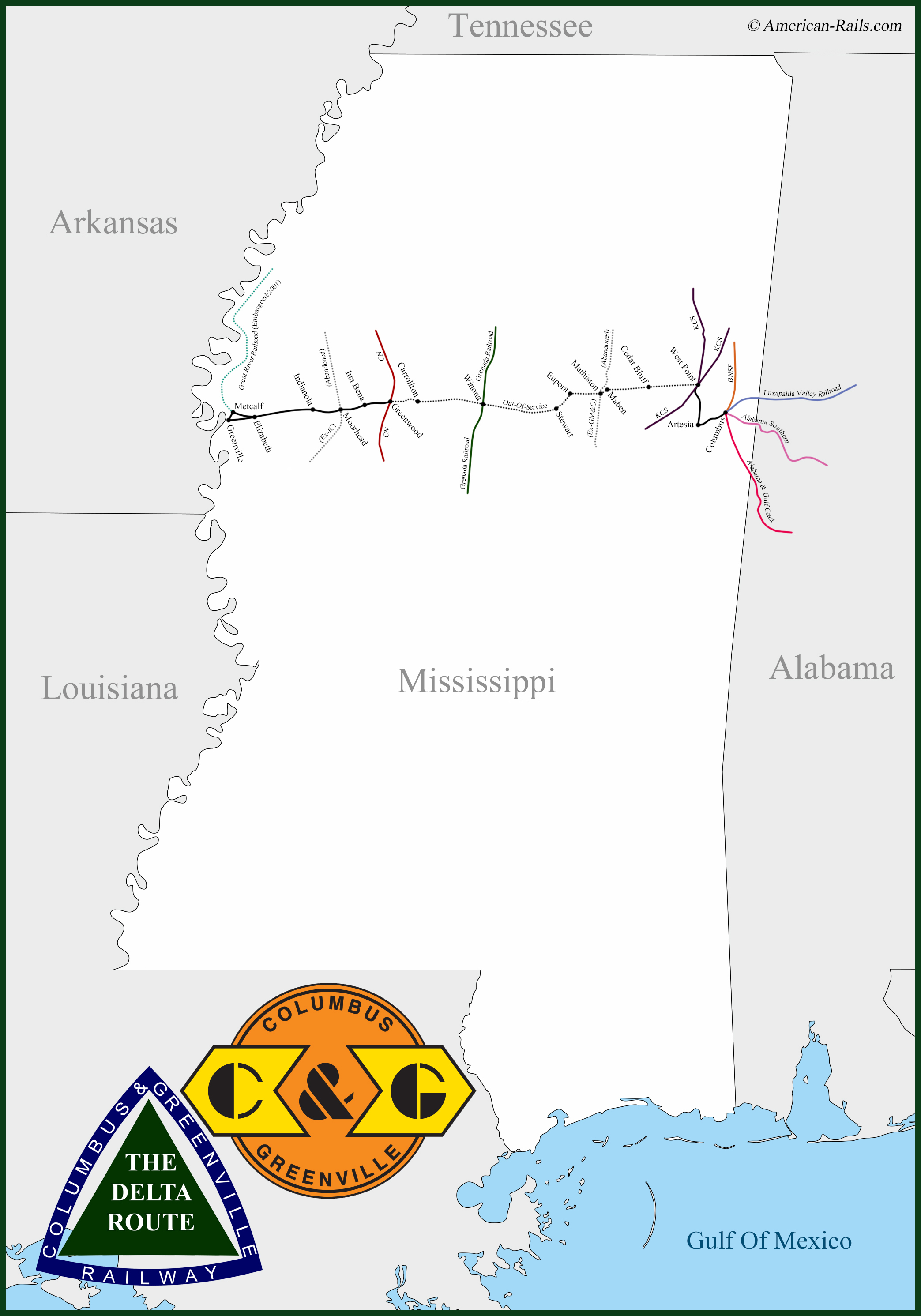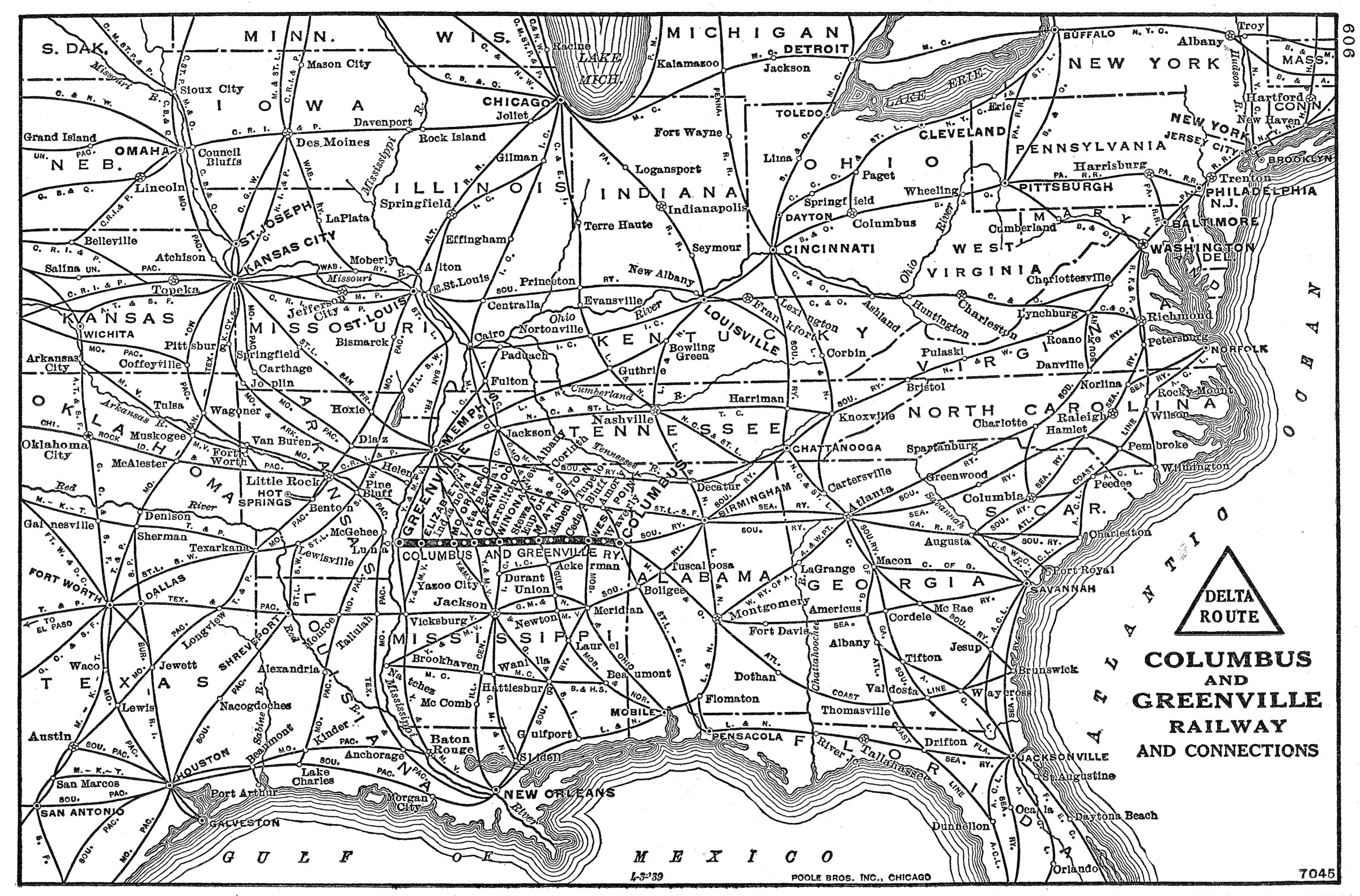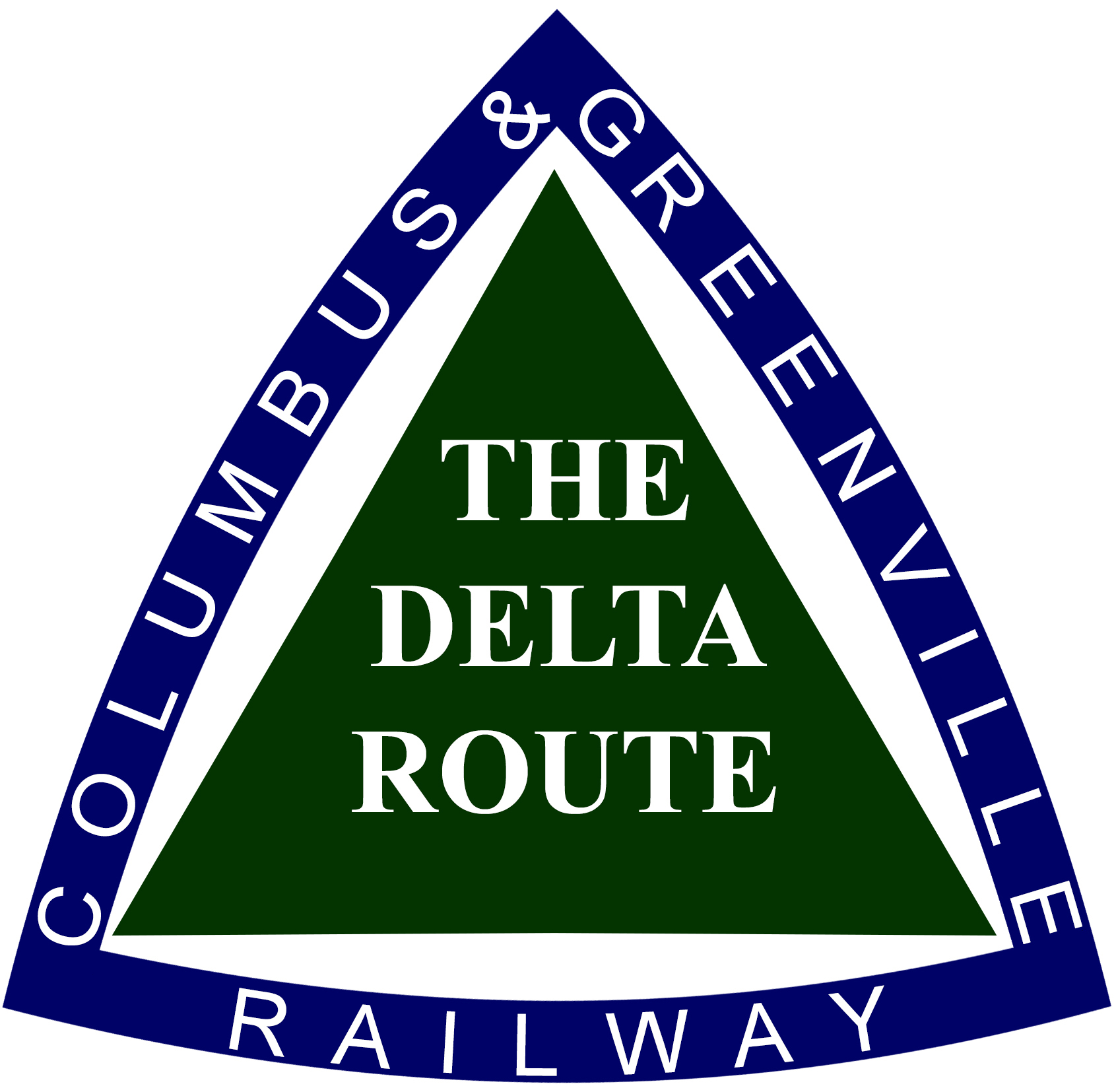Columbus and Greenville Railway: "The CAGY"
Last revised: August 30, 2024
By: Adam Burns
The Columbus and Greenville Railway, otherwise known by its reporting marks (CAGY), is a historic short line dating back to the early 20th century.
The system was a longtime component of the Southern Railway although always remained a subsidiary due to Mississippi state law.
Its name was changed to the Columbus & Greenville Railroad in 1920 and was spun-off from the Southern three years later.
The CAGY maintained a linear network, running from the Mississippi River at Greenville to Columbus, near the Alabama state line.
The system was bolstered by numerous Class I connections including the Illinois Central (Greenville, Stoneville, Elizabeth, Moorhead, Greenwood, Winona and West Point); Gulf, Mobile & Ohio (Mathiston, Maben, West Point, and Columbus), Southern (Columbus), and St. Louis-San Francisco Railway (Columbus).
Photos
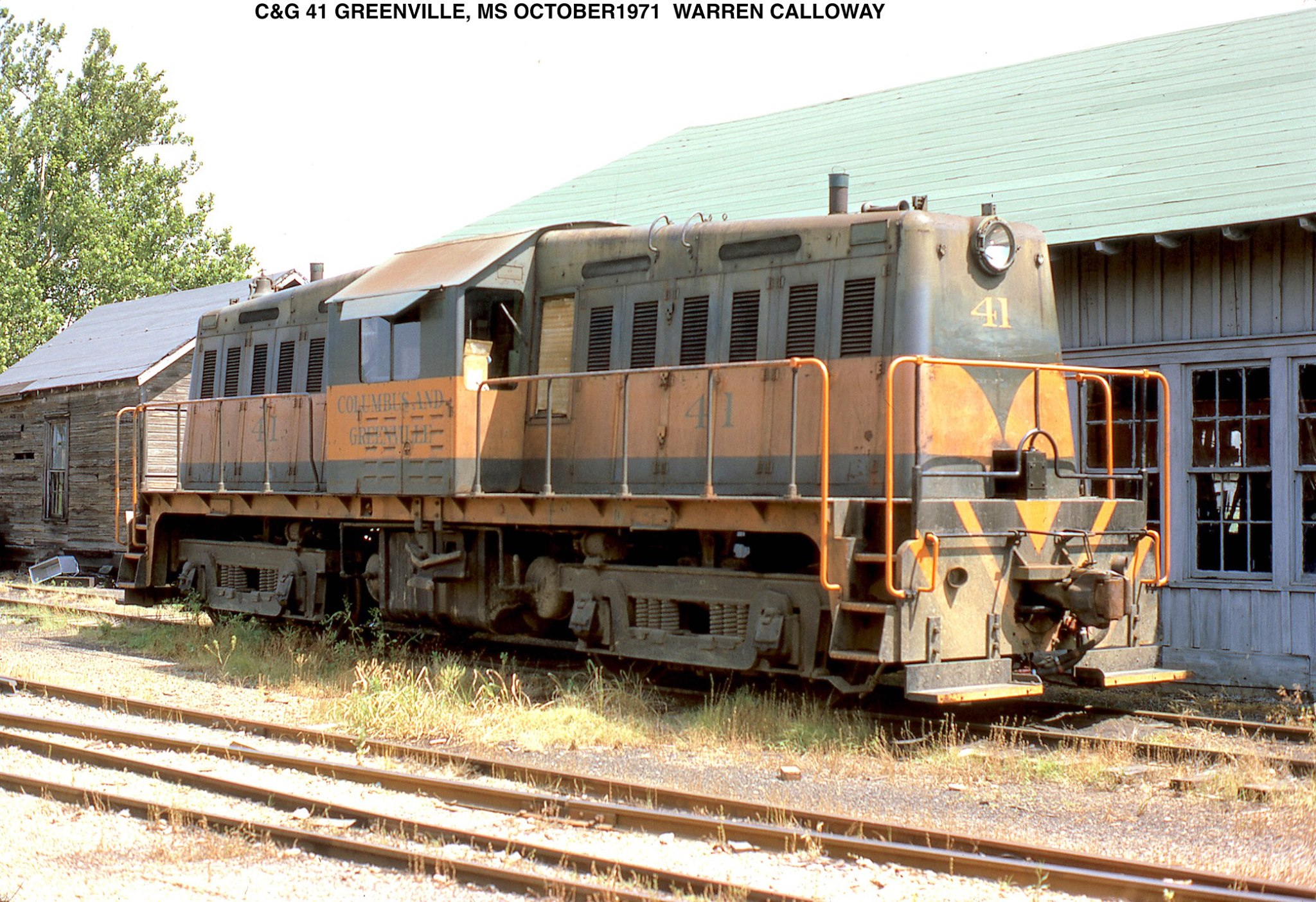 Columbus & Greenville 65-tonner #41, a product of Whitcomb, was photographed here by Warren Calloway at Greenville, Mississippi in October, 1971.
Columbus & Greenville 65-tonner #41, a product of Whitcomb, was photographed here by Warren Calloway at Greenville, Mississippi in October, 1971.History
Mergers and bankruptcies, abandonments, and spin-offs have hurt the company over the years as it has lost many of its interchange points.
In 2001 severe washouts forced the railroad to embargo 89.5 miles of main line between West Point and Greenwood.
This trackage remains out of service today under Genesee & Wyoming, Inc. which purchased CAGY Industries in 2008.
The latter company operated the original Columbus & Greenville as well as short lines Luxapalila Valley Railroad and Chattooga & Chickamauga Railway.
The future of this property is, unfortunately, in doubt following two decades of no use.
However, one of the strengths of the original CAGY was its through route, the shortest trip across the northern part of the state. In addition, the town of Winona includes a connection to short line Grenada Railroad (ex-IC).
The first spike of the Greenville, Columbus and Birmingham Railroad, today known as the Columbus & Greenville Railway was driven in Greenville on January 5, 1879 by Mrs. H. B. Theabold who was a prominent Greenville, Mississippi citizen.
The track was completed eastward to Stoneville on March 31, 1878, and the first scheduled passenger service was started April 8, 1878, with two round trips scheduled daily between Greenville and Stoneville, Mississippi.
Passenger train service was extended as each track segment was completed. The construction of the station at 205 Central Avenue was authorized in 1886 and the building was completed in 1888.
It was what I call mock fortress architecture in which the top of the walls all around looked like a fort with no overhang and fake gun ports.
The main line was completed between Greenville and Atlanta June 18, 1889, and through train scheduled service began between Greenville and Atlanta on July 8. 1889.
System Map (Present Day)
The ownership and name of the railroad also changed to Georgia Pacific Railroad in 1889. A through Pullman sleeping car was operated on this train for many years.
On September 1, 1894, the ownership and name again changed to Southern Railway in Mississippi. The Southern Railway in Mississippi was part of the Southern Railway, but, in 1892 the Mississippi legislature passed a law that any new railroad operating in Mississippi had to be chartered in Mississippi, thus the “IN Mississippi” part of the name.
In 1912 the Southern Railway in Mississippi enlarged the station building with a fifty foot addition on the rear and completely remodeled the building.
They removed the “fortress” wall tops and added roof overhangs all around the building to the basic present look of the building.
On November 6, 1920 the Southern Railway in Mississippi changed the name to Columbus and Greenville Railroad.
On August 6, 1923 Mr. A. T. Stovall purchased the railroad and renamed it the Columbus and Greenville Railway. During the Columbus and Greenville era, the premier passenger train between Columbus and Greenville was the “Deltan”.
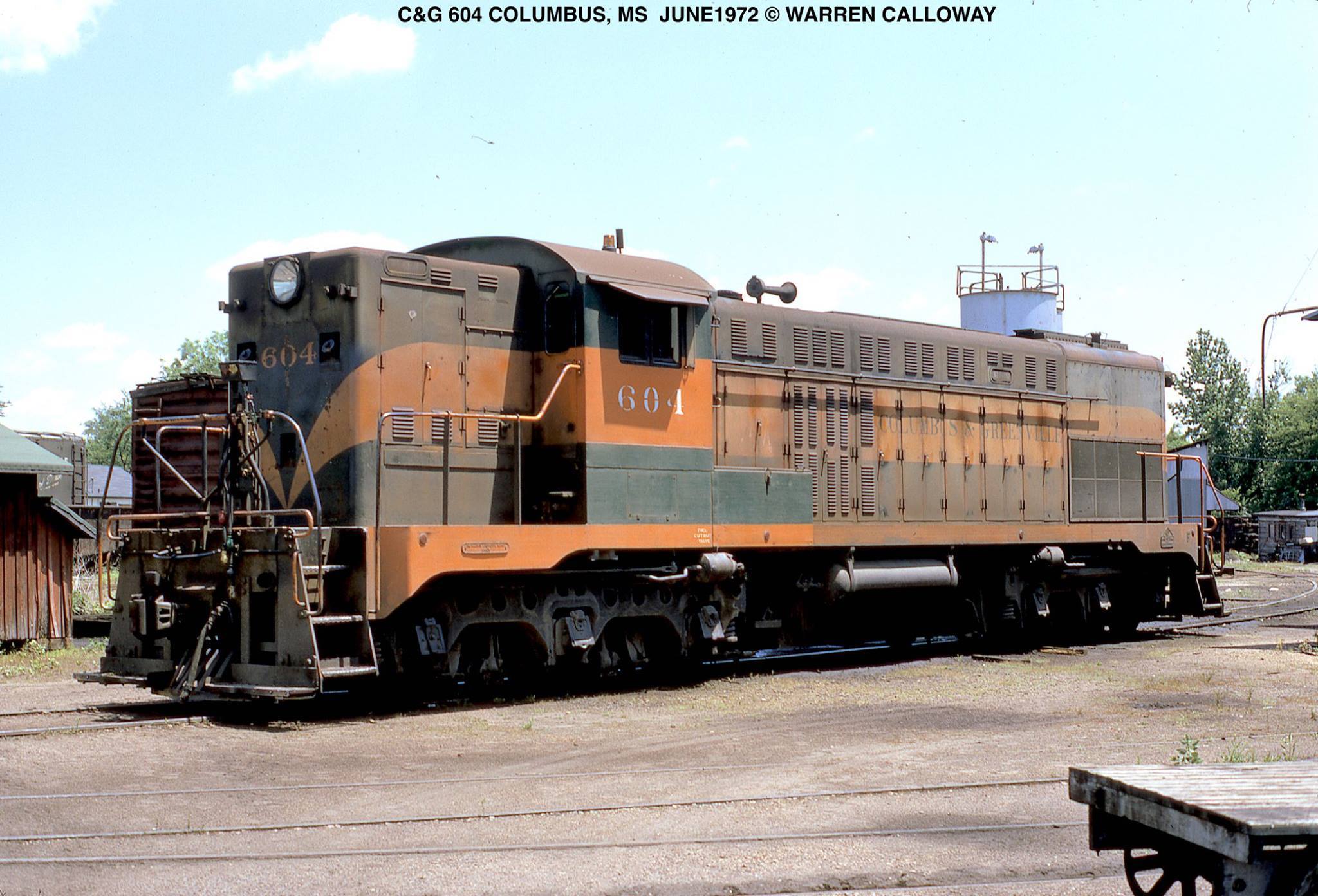 Columbus & Greenville DRS-6-4-1500 #604 at Columbus, Mississippi in June of 1972. Warren Calloway photo.
Columbus & Greenville DRS-6-4-1500 #604 at Columbus, Mississippi in June of 1972. Warren Calloway photo.The “Deltan” C&G Train Number 11/12 made a across platform connection with the Southern Railway Train Number 11/12 to and from Atlanta. The “Deltan” was completely air conditioned in 1938.
The last run of the Deltan was July 15, 1948. All scheduled passenger service ended in 1949 although special passenger trains were still run.
System Map (1940)
The last “Special” was a football special from Columbus to Greenville and back in 1957. The Stovall family operated the railroad until it was taken over by the Illinois Central Gulf Railroad on September 29, 1972.
The Illinois Central Gulf, also formed in 1972, was a massive system (for its time), controlling much of the trackage in the center of the country along the Mississippi River between Chicago and the deep south near New Orleans.
Logo
It consisted of the Gulf, Mobile & Ohio and Illinois Central railroads, which both operated in the same regions and served many of the same markets. Similarly, both railroads were unique in that they operated north-south main lines instead of the more traditional east-west systems.
On October 30, 1975, a group of local investors purchased the railroad and operated it as the Columbus and Greenville Railway.
Diesel Roster
| Road Number | Model Type | Builder | Year Built | HP | Notes |
|---|---|---|---|---|---|
| 41 | 65-Ton | Whitcomb | 1944 | 650 | Ex-U.S. Army #8440, scrapped. |
| 42 | 65-Ton | Whitcomb | 1944 | 650 | Ex-U.S. Army #8459, scrapped. |
| 501 | SW-1 | EMD | 6/1940 | 600 | Ex-TRRA #501, sold for scrap to M.D. Friedman. |
| 505 | SW-1 | EMD | 9/1947 | 600 | Ex-TRRA #505. |
| 506 | SW-1 | EMD | 9/1947 | 600 | Ex-TRRA #506, sold for scrap to M.D. Friedman. |
| 507 | SW-1 | EMD | 1946 | 600 | Ex-IC #607, traded for former Florida East Coast GP7's. |
| 508 | SW-1 | EMD | 1947 | 600 | Ex-TRRA #508, sold to United Cement of Artesia, Mississippi in 1981. |
| 509 | SW-1 | EMD | 6/1946 | 600 | Ex-IC #608, traded for former Florida East Coast GP7's. |
| 514 | SW-1 | EMC | 3/1940 | 600 | Ex-South Shore Line #601; built as Buffalo Creek Railroad (New York) #42. Acquired in 1975 and sold to Babcock & Wilcox of West Point, Mississippi in 1977. |
| 520 | SW-1 | EMC | 6/1939 | 600 | Leased from ICG circa 1972. Built as Wabash #103 and later worked on the Bonhomie & Hattiesburg Southern as #1. The BH&S was merged into the new Illinois Central Gulf in 1972. The unit returned to ICG sometime between late 1976 and early 1977. |
| 521 | SW-1 | EMC | 6/1939 | 600 | Leased from ICG circa 1972. Built as Wabash #102 and later worked on the Bonhomie & Hattiesburg Southern as #2. The unit returned to ICG sometime between late 1976 and early 1977. |
| 522 | SW-1 | EMC | 12/1939 | 600 | Ex-IC #601, sold to Port Bienville Railroad. |
| 523 | SW-1 | EMD | 6/1946 | 600 | Ex-IC #606, sold to Marshall Durbin Company. |
| 524 | SW-1 | EMD | 6/1946 | 600 | Ex-IC #611, sold to Port Bienville Railroad. |
| 525 | SW-1 | EMD | 9/1941 | 600 | Built as Elgin, Joliet & Eastern #240; sold to Fernwood, Columbia & Gulf as #600. The FC&G was merged to the ICG in 1972 where the unit became #611. It was sold to CAGY that year. Later sold to Vulcan Materials. |
| 601 | DRS-6-4-1500 | Baldwin | 10/1946 | 1500 | Acquired new. Preserved and on display in Columbus, Mississippi. |
| 602 | DRS-6-4-1500 | Baldwin | 10/1946 | 1500 | Acquired new. Wrecked and retired in 1961. |
| 603 | DRS-6-4-1500 | Baldwin | 12/1946 | 1500 | Acquired new. Scrapped in the early 1980's. |
| 604 | DRS-6-4-1500 | Baldwin | 1/1947 | 1500 | Acquired new. Scrapped in the early 1980's. |
| 605 | DRS-6-4-1500 | Baldwin | 1/1947 | 1500 | Acquired new. Scrapped in the early 1980's. |
| 606 | AS416 | Baldwin | 9/1951 | 1500 | Acquired new. Preserved at the Illinois Railway Museum. |
| 607 | SW-1 | EMD | 6/1946 | 600 | Ex-IC #9022. Sold to Harvest States Cooperative as #507. |
| 608 | GP7 | EMD | 9/1952 | 1500 | Ex-FEC #608. Scrapped 4/2009. |
| 614 | GP7 | EMD | 9/1952 | 1500 | Built as FEC #614, later worked on the South Shore Line. Scrapped 4/2009. |
| 615 | GP7 | EMD | 10/1952 | 1500 | Built as FEC #615, later worked on the South Shore Line. Scrapped 4/2009. |
| 618 | GP7 | EMD | 10/1952 | 1500 | Built as FEC #618, later worked on the South Shore Line. Scrapped 4/2009. |
| 619 | GP7 | EMD | 10/1952 | 1500 | Built as FEC #619. Scrapped 4/2009. |
| 621 | GP7 | EMD | 10/1952 | 1500 | Built as FEC #621. Scrapped 4/2009. |
| 701 | SD28 | EMD | 9/1965 | 1800 | Acquired new. Sold to ICG as #9450 in 1972. |
| 702 (1st) | SD28 | EMD | 9/1965 | 1800 | Acquired new. Sold to ICG as #9451 in 1972. |
| 702 (2nd) | GP9 | EMD | 7/1955 | 1750 | Ex-Southern/CNO&TP #6246, acquired 1983. |
| 703 | GP9 | EMD | 7/1955 | 1750 | Ex-Southern/CNO&TP #6248, acquired 1983. |
| 704 | GP9 | EMD | 8/1955 | 1750 | Ex-Southern #8214, acquired 1983. |
| 801 | CF7 | EMD | 5/1951 | 1500 | Built as Santa Fe F7A #254-C. Rebuilt as CF7 #2450 in 7/1977. |
| 802 | CF7 | EMD | 4/1950 | 1500 | Built as Santa Fe F7A #234-L. Rebuilt as CF7 #2451 in 7/1977. |
| 803 | CF7 | EMD | 11/1953 | 1500 | Built as Santa Fe F7A #273-L. Rebuilt as CF7 #2465 in 3/1977. |
| 804 | CF7 | EMD | 12/1952 | 1500 | Built as Santa Fe F7A #308-L; renumbered 345-L in 5/1973. Rebuilt as CF7 #2464 in 3/1977. Scrapped 4/2009. |
| 805 | CF7 | EMD | 6/1956 | 1500 | Built as Santa Fe F9A #285-L. Rebuilt as CF7 #2434 in 10/1977. Scrapped 4/2009. |
| 806 | CF7 | EMD | 5/1951 | 1500 | Built as Santa Fe F7A #257-L. Rebuilt as CF7 #2548 in 10/1977. Scrapped 4/2009. |
| 807 | CF7 | EMD | 5/1950 | 1500 | Built as Santa Fe F7A #239-C. Rebuilt as CF7 #2505 in 8/1974. Scrapped 7/2011. |
| 808 | CF7 | EMD | 12/1949 | 1500 | Built as Santa Fe F7A #224-C. Rebuilt as CF7 #2483 in 1/1975. |
| 1000 | GP7R | EMD | 8/1952 | 1500 | Built as Chicago, St. Paul, Minneapolis & Omaha #157. Rebuilt as Chicago & North Western GP7R #4469. Scrapped 4/2009. |
| 1001 | GP7R | EMD | 4/1951 | 1500 | Built as Chicago & North Western #1550; rebuilt as GP7R #4477. Out of service. |
| 1002 | GP7R | EMD | 5/1953 | 1500 | Built as Chicago & North Western #1659; rebuilt as GP7R. |
| 1003 | GP7R | EMD | 8/1952 | 1500 | Built as Chicago, St. Paul, Minneapolis & Omaha #161. Rebuilt as Chicago & North Western GP7R #4467. |
| 1543 | SW1504 | EMD | 8/1973 | 1500 | Built as NdeM #8848. |
| 1586 | GP7 | EMD | 9/1951 | 1500 | Built as CB&Q #230; later became BN #1586. Scrapped 4/2009. |
| 1804 | GP11 | EMD | 1/1956 | 1850 | Built as Illinois Central GP9 #9185; rebuilt by IC as GP11 #8736. |
| 1806 | GP11 | EMD | 3/1953 | 1850 | Built as Illinois Central GP9 #8967; rebuilt by IC as GP11 #8747. |
| 2011 | GP38 | EMD | 1/1970 | 2000 | Built as Southern #2785; became Norfolk Southern #2785. Formerly CAGY #2785. |
| 2094 | GP38 | EMD | - | 2000 | - |
| 2777 | GP38 | EMD | 11/1969 | 2000 | Built as Southern #2777. |
| 2880 | GP38 | EMD | 6/1966 | 2000 | Built as Norfolk Southern (original) #2001; became Southern #2880 and then NS #2880. |
| 3310 | SD40-2 | EMD | 6/1966 | 3000 | Built as Milwaukee Road #173, later became Soo #6346 then EMD Leasing #6346. |
| 3312 | SD40-2 | EMD | 7/1976 | 3000 | Built as Missouri Pacific #3220, renumbered 6004 then became Union Pacific #3904. |
| 7004 | CF7 | EMD | 9/1949 | 1500 | Built as Santa Fe F7A #38-C, became CF7 #2564 in 7/1977. Scrapped 4/2009. |
| 8715 | GP11 | EMD | 8/1956 | 1850 | Built as New Haven GP9 #1208, sold to ICG and rebuilt as GP11 #8715. |
| 8718 | GP11 | EMD | 8/1956 | 1850 | Built as New Haven GP9 #1224, sold to ICG and rebuilt as GP11 #8718. |
| 8720 | GP11 | EMD | 6/1963 | 1850 | Built as IC GP18 #9423, rebuilt by ICG as GP11 #8720. |
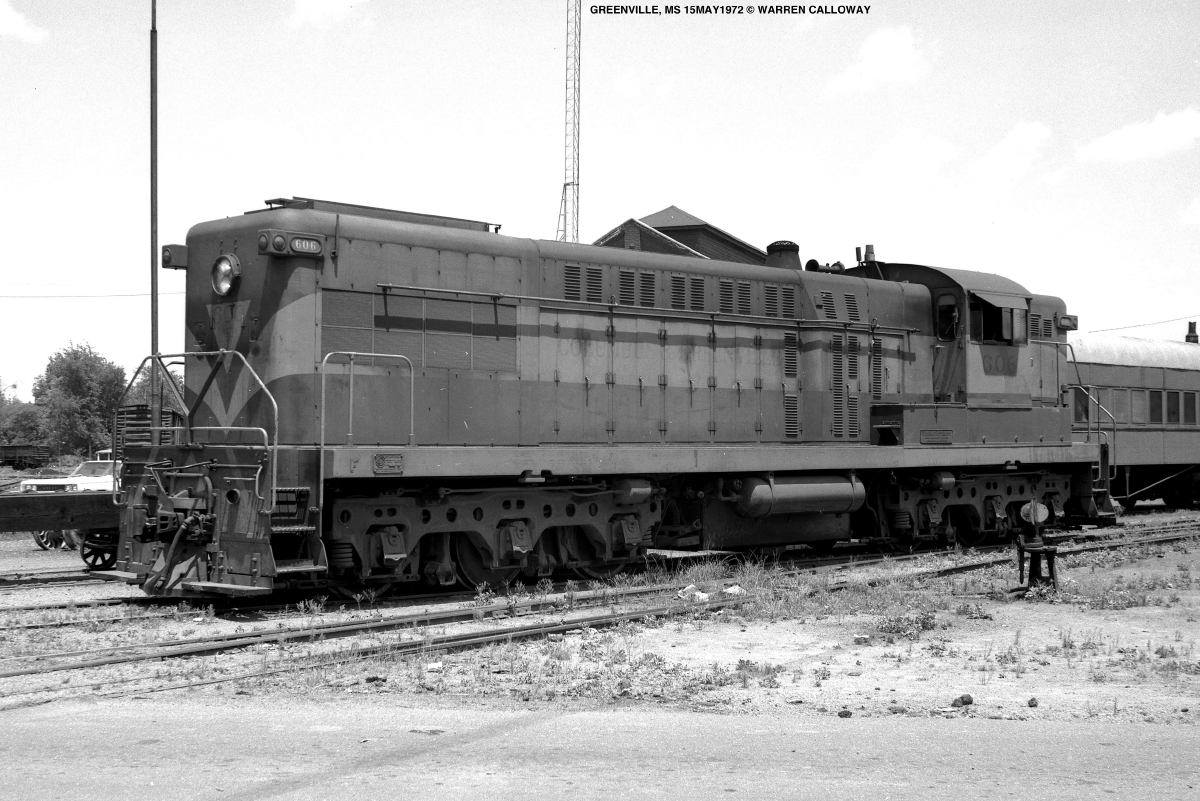 Columbus & Greenville's only AS416, #606, is seen here in Greenville, Mississippi on May 15, 1972. Warren Calloway photo.
Columbus & Greenville's only AS416, #606, is seen here in Greenville, Mississippi on May 15, 1972. Warren Calloway photo.The
railroad continues to operate today as the Columbus and Greenville
Railway although ownership changed in July, 2008, to Genesee and
Wyoming, Inc., which owns and operates railroads in the United States
and other countries as well.
The current Columbus and Greenville Railway operates between Greenville and Greenwood and between Columbus and West Point.
The track is out of service between Greenwood and West Point although efforts are underway to possibly restore service between Greenwood and West Point.
Most information on this page is courtesy of Harold Holiman.
Recent Articles
-
Track Tales: Discover Missouri's Rail Heritage
Feb 28, 25 09:09 PM
Missouri's importance as a major railroading hub is unquestioned with St. Louis being a critical market. Today, several museums preserve this history. -
Step Into History at an Illinois Railroad Museum
Feb 28, 25 07:17 PM
No state contained more railroads than Illinois and today several museums preserve their memory and importance. -
Rails of History: Colorado's Train Museums
Feb 28, 25 03:18 PM
Colorado was once home to the densest collection of narrow-gauge railroads. Several museums preserve the state's rail history today.
